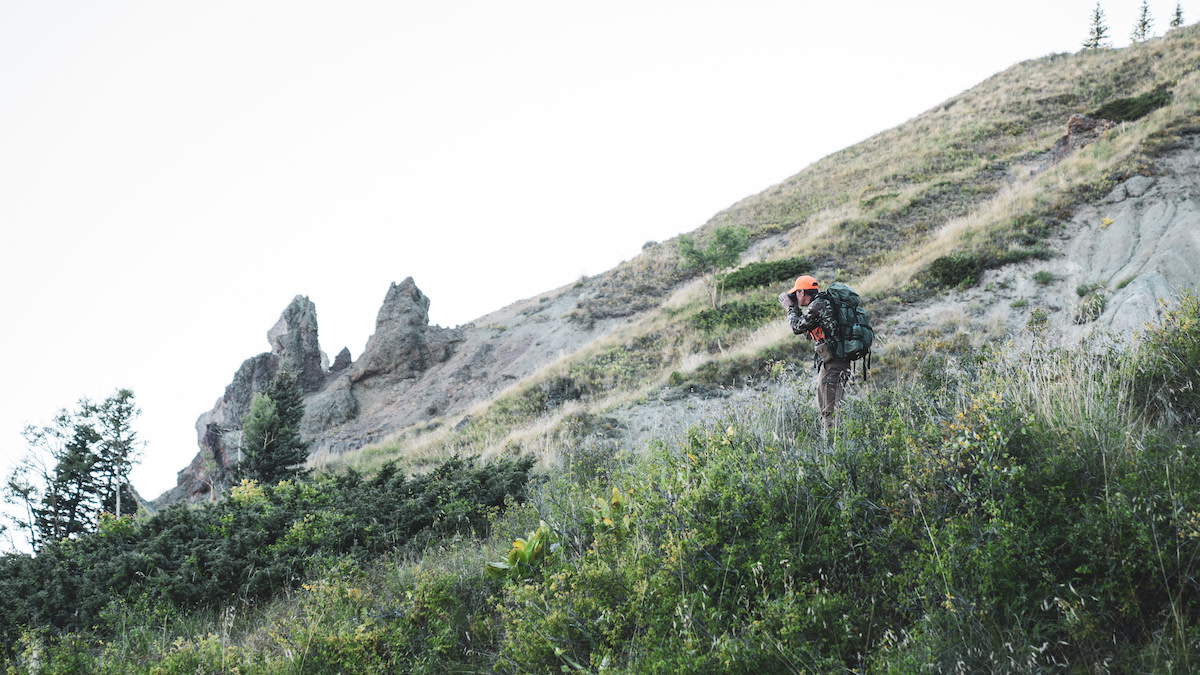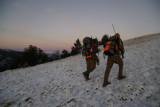
I was alone and creeping silently through a boggy, hidden stand of aspen and willow deep in the timber, wandering a circuitous path toward a meadow where we’d spotted a small elk herd earlier. Suddenly, something large stood up from its bed behind a wide spruce not 30 yards in front of me.
With elk on the mind, I mewed with the Phelps Maverick diaphragm call on the roof of my mouth. The animal stopped. I nocked an arrow. But instead of a bull, a black bear rounded the corner in full predatory stalk. Head down, it came at me with a mix of curiosity and intent on its reddish-brown face. Dressed in full Fusion camo, I assumed the bear was looking past me, searching for that elk calf it just heard. But at 10 yards I decided it was close enough.
Take it Easy I wouldn’t have had an opportunity on that bear if I was in any sort of hurry to get somewhere. I feel it’s unlikely I would have even seen it if I wasn’t hunting alone. I know there would've been no chance if I wasn’t hunting into the wind.
Still-hunting, the practice of sneaking very slowly through the woods, has deep roots in the literature and tradition of American hunting, but I wonder if some members of the younger generations may not fully appreciate its value—especially when it comes to the massive country of the West. Many people I’ve accompanied in the woods recently seem almost singularly focused on getting to the next glassing point or the top of the next ridge fastest. I get it—I used to do the same thing and regularly still do, but a number of experiences over the years have drastically changed my approach.
When I first started hunting the wide-open scablands of Eastern Montana, the Dakotas, and Nebraska, I was always trying to cover miles, see as many areas as possible, get all the way to the best vantage point to find animals through a lens. But another thing that open country provides is visual proof of all the animals you’re jumping up through incautious wandering. The same thing happens in the woods, you just can't see it so clearly. I got tired of watching elk blow up out of a timber patch I was just trying to get through, or muleys jumping out of a gulley hideout because I marched over the rim.
Eventually I realized that didn’t have to happen. I realized I could still get where I’m going without spooking off all the animals between here and there. I realized there was even a chance of shooting those animals.
I know this is no revelation for many of you. But, quite honestly, I’ve had to tell 75% percent of the folks I’ve hunted with the last few years to slow the hell down at one point or another. Your eyes simply can’t cover the ground in front of you as fast as your feet can. A deer hears a stick break and it runs. It’s amazing how many animals will remain calmly bedded on the other side of a coulee when you stop before the ridgeline and crest it one step at a time, scanning both sides with your binos as you go. The silhouette of your ballcap is a lot less intrusive than that of your torso.
My success rate increased dramatically when I slowed my hiking down and took a more deliberate, sneaky approach to moving through good habitat—even wide-open plains. It’s amazing how little cover can hide a deer. But that education may have provided me even greater lessons for hunting the woods and mountains.
Misty Mountain Hop It seems that somewhere during the relatively recent rise of mountain hunting culture, the style got coopted by some muscular machismo that prides biceps and hard hiking above all else. I’m all for covering ground when you have to, but cruising the woods too fast is simply a recipe for jumping animals.
Relax—you aren’t Cameron Hanes. Hunting has always been an exercise in stealth and awareness. Take a page out of the Northeast whitetail tracker’s book and pause between steps. If your momentum is too quick to stop on a dime, you’re going too fast. This may not be true for whitetails, but elk and mule deer don’t always bolt immediately when they hear disturbance. They’re a lot less likely to split if that noise is minimal and you freeze right away when they stand up. With elk, a quick cow chirp will often put their mind at ease and may even draw a bull (or bear) toward you. Muleys, and sometimes even whitetails, will frequently try to identify the source of noise before running off, which works to your advantage if you are able to go rigid right away. That may provide the few seconds you need to get a projectile moving downrange.
Several years ago I was hiking briskly but quietly down off the mountain where I’d been chasing elk all day. Just before last light I caught motion in the corner of my eye and stopped hard just before a young whitetail buck stepped into the open. As he passed behind the next tree, I nocked an arrow and drew. It was late September and I was fresh out of game meat, so I thumped the basket buck at 20 yards as he walked unaware right into the trail. A lot of fuss gets made about whitetail alertness, but you can still beat it on the ground with situational awareness and the ability to freeze mid-step. Elk, mule deer, black bears, and pronghorn are more forgiving. I've even snuck up on coyotes at close range while moving super slowly into the wind.
Slow Ride There are a lot of regional names for this approach, many of them fishing-related for some reason: Mooching, trolling, cruising, etc. But one of my favorite concepts comes to us from old-school mountain goat and sheep hunters like Jack O’Connor: the lost car keys trick.
All that means is wandering with apparent aimlessness and slowness—looking at the ground and acting in a specifically non-predatory, non-aggressive manner—as if you were searching for your keychain. High mountain hunters often use this tactic to close the distance to their quarry on wide-open mountainsides when no cover is available. Herbivores are a lot less suspicious of something that acts like another herbivore—not a sneaky carnivore creeping up with murderous intent. I saw this work on my friend Land Tawney’s bighorn hunt in Montana, and I’ve applied some elements to elk and deer as well.
Hike fast and game animals will run away from you fast. Hike slowly and they may not feel the same urgency. When I have places to be but want to stay in the game, I’ll use a somewhat shuffling gait—not super slow, but definitely not fast. This more measured approach has the secondary benefit of reserving energy for those wind sprints or quick cuts you often need put yourself in position for the moment of truth. If you’re gassed from coming up the hill too fast, it will be harder to put the legs into hyperdrive to cut off an animal or set up to take a shot.
Walk This Way Still-hunting truly requires a mental reset for a lot of people—especially when they’ve been indoctrinated in the idea that success in Western landscapes only requires covering a lot of miles with boots or binoculars. Some of the best advice I ever heard is that it’s better to cover one mile well than 10 miles poorly. This strategy is a valuable tool in your toolbox whether you’re creeping thick cover all day or just poking through the occasional timber stand. It’s a great Plan B or C when the elk aren’t calling, the bucks aren’t rutting, or nothing is visible due to high sun, fog, or precipitation. Take the fight to them and get right into the cover where they actually are.
There are levels to Western still-hunting, of course, and times to employ or abandon it based on circumstance—that’s the subtle art. Oftentimes you know the elk are 2,000 feet up the mountain and you just have to bust ass to get up to them. But you sure better slow the hell down once you do. Other times it pays to just move super slow through likely habitat all day, especially when snow or rain can dampen your noise. I got my Boone & Crockett Sitka blacktail still-hunting through old-growth timber in the rain, and he never knew I was there.
Situational awareness is the name of the game. Scan your whole field of view, not just what’s right ahead. Pause between steps. Stay in the shadows. Check your back trail. Observe sign and learn from it. Glass frequently, even in dense cover. Don’t make more noise than you can hear over. Crest ridges and enter openings one short step at a time. Walk into the wind or across it, checking the direction often. Look at the map for saddles, funnels, and other potentially fruitful areas to explore. Be prepared to rack a round or string an arrow at a moment’s notice. Go alone, or at least put one lead hunter way out ahead. If you have to talk, do so in hushed whispers. Immerse yourself in the experience and become part of the woods.
The black bear kept coming at me until I was sure it didn’t have cubs and that the situation was quickly becoming a bit sporty. I drew my bow, the bear lifted his head, the arrow entered his chest and continued its flight out the back of his ribcage. He ran 30 yards, roared, and expired. I’d have more tags and a lot less bear grease if I didn’t bring the time or patience to slip slowly through the woods, ready for whatever might happen.
Feature image via Seth Morris.






Conversation